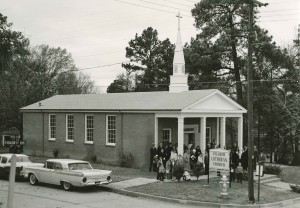
The saints of Pilgrim Lutheran Church congregate outside the sanctuary after a service in the early 1960s. (The pull-in parking off Broadway and Florey present today was added some 20 years later.)
The church is first and foremost the assembly of all believers among whom the Gospel is preached in its purity and the holy sacraments are administered according to the Gospel (Augsburg Confession VII). Any subset of “all believers” that gathers around the Gospel and sacraments is also church, and in a lesser-sense the term “church” is transferred to the building where those believers assemble to receive the forgiveness of sins and thus eternal salvation.
Only by God’s grace, mercy, and providence are we able to praise Him for 60 years of salvation offered at Pilgrim Lutheran Church, Kilgore, Texas. And, to God alone is all glory for what He through those years has done by offering forgiveness to the people in His house at the corner of Broadway and Florey in the East Texas community of Kilgore. Our prayer is that He continues to offer His gifts here for years to come.
The following narrates Our History from Mission to Chartering; in terms of Property, Construction, and Other Buildings; Word and Sacrament Ministry; Parish and Circuit Life; and Reflections with a View to the Future. (For a more chronological approach, see Our Milestones.)
FROM MISSION TO CHARTERING ↑ Back to top
On December 29, 1948, a group of Lutherans, thought to be mostly from Trinity Lutheran Church, Tyler, Texas, met at the home of A. C. Hollinger in Kilgore to discuss opening a new mission in Kilgore. Trinity later granted the group’s petition for a preaching station, and, on February 6, 1949, Rev. D. D. Dautenhahn of Trinity conducted the first service, held in the former American Legion Hall that used to be on Business 259 where Walgreens is today (the hall was relocated down Lantrip from the post office and, until its demolition in 2023, was a work in progress known as Reunion Hall). As prospects for a congregation improved, the Mission Board of the Texas District of The Lutheran Church—Missouri Synod took over responsibility for the Kilgore mission.
About one and one half years later, on August 27, 1950, the Mission Board was asked to consider calling a full time pastor for the Kilgore field, but the Board replied that such action was impossible at that time. About another one and one half years later, on February 18, 1952, with a vicar expected, word came that the Board had requested a seminary candidate to serve the Kilgore preaching station, spurring serious thinking about organizing as a congregation.
Three months later, on May 22, 1952, a congregational constitution was drawn up for study. Later that same year, on September 17, 1952, that constitution was accepted, and Pilgrim Lutheran Church became an organized congregation, with seven men signing her charter. The State of Texas granted the congregation a charter of incorporation on November 15, 1952, and the Lutheran Church—Missouri Synod officially received the congregation on March 20, 1954.
PROPERTY, CONSTRUCTION, AND OTHER BUILDINGS ↑ Back to top

A sign on the corner of Broadway and Florey in 1953 told passersby both what was coming to the location and where the congregation was meeting at that time. A note on the back of a copy of this photo says it was taken at the start of construction.
Less than one year after chartering, on March 30, 1953, the congregation, with the help of a loan from the Texas District Lutheran Church Extension Fund, purchased for $7500 the property on the corner of Broadway Boulevard and Florey Street in Kilgore. Later that same year, on July 15, 1953, the congregation appointed a four man building committee and petitioned the Mission Board for permission to begin building a church. On December 22, 1953, a colonial-type building was chosen, and work began on the final drawings. The following summer, on June 23, 1954, the congregation opened bids for construction, and, after the architect and contractor cut costs, the contract was awarded to Canterbury Construction Company of Kilgore, which began construction August 2, with groundbreaking ceremonies held August 8.
About three months later, on November 7, the congregation moved into its new church, although work was still incomplete (for example, pews were not added until December of 1956). On December 12, the new church building was dedicated to the glory of God, with Pilgrim’s pastor, the Rev. John F. Meyer, conducting the service and Texas District Mission Executive Director, the Rev. A. O. Rast, preaching; 142 worshipers were present.
The original purchase of property included a house, which was moved next door to where the church was to be constructed. Shortly after that 1953 purchase, the house was remodeled for use as a parsonage, and Pastor Meyer moved in on September 27, 1953. On November 6, 1956, the congregation resolved to look for a new parsonage, and it purchased 1508 East Lantrip on March 14, 1957. The house next door to the church was enlarged in 1957 to provide room for a Sunday School and was used as a parish hall until 1970, when it was sold and moved from the property.
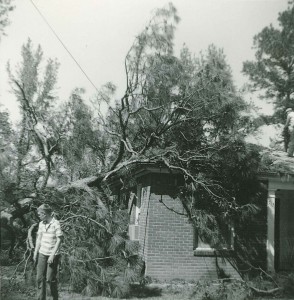
In the 1960s, member Larry Hudson (lower left) and his member father, Glenn Hudson (upper right), survey the damage to the original church building after a tree fell over on it during a storm, largely impacting what was then Pastor Wageman’s study (the current kitchen).
Around the same time in 1970, the congregation, with the help of member Glenn Hudson, made the high bid on a building being sold by the Getty Oil Company, and, on August 20, 1970, the congregation had it moved to the property for use as a Sunday school building, dedicated September 12, 1971. This building, the present office and Sunday School building, was originally constructed in 1958 as an office building for the Tidal Pipeline Camp near Joinerville, Texas. When that camp was closed around 1960, the building was moved to the Nat Bean “A” Camp of Tidewater Oil Company just outside Kilgore, where it was used in various ways until being vacated and sold to Pilgrim. At one point, Joan Wageman, the wife of Pilgrim’s pastor Harold Wageman, worked in the building as a secretary for Tidewater, officed in what is now the younger children’s Sunday School room.
On March 14, 1973, the congregation authorized its trustees to sell the parsonage at 1508 East Lantrip, which had been purchased in 1957. Proceeds from the sale of that parsonage helped fund repairs to and expansion of the main church building, carried out from July 1, 1973, through the summer of 1974. Louisiana Soil Stabilization Company, All Around Construction, and some volunteer labor carried out foundation and steeple work, painted the interior and exterior of the church and education building, carpeted the church, hung a new dossal curtain and window drapes, installed a new central heating and air conditioning unit, suspended a ceiling with new lighting fixtures in the sanctuary, paved the parking lot west of the education building, expanded the fellowship hall, and converted the old office to a kitchen (including installing a serving window, stove, refrigerator, and hot water heater).

Nearly every room in a donated Sunday School building was damaged when a red oak tree fell over on the building during a 2008 storm. Insurance proceeds from the destruction of the building and the storm’s damage to other buildings paid for repairs to those buildings and went into savings, some of which were used for the 2012 sanctuary remodeling.
More than a decade later, on October 2, 1983, member B. K. Thomas donated a building to serve as the Sunday School building, leaving the purchased building to be used for offices and nursery. Nearly fifteen years later, the donated building was destroyed on April 6, 2008, when a red oak tree fell on it during a storm. The building was removed in July of that year, and the approximate $80,000 in insurance proceeds remaining from the claim for that and other storm damages were invested into certificates of deposit.
The main church building was not neglected in the meantime. A new air conditioner and heater were installed in the church and parish hall in January 2001, and, in May of 2006, the narthex nursery was refurbished. As a result of the same 2008 storm that destroyed the donated Sunday School building, the roofs on the sanctuary, parish hall, and office building had to be replaced in July 2009, using some of the insurance proceeds from that storm.
The remaining balance of those insurance proceeds from the destruction of the donated building was available to help fund remodeling carried out in the summer of 2012 in preparation for the congregation’s 60th anniversary celebration. Outside, the steeple was recovered to repair the 2008 storm damage, rotted wood in the entryway to the parish hall was replaced and the whole entryway painted, and all of the original windows in the Sanctuary and Parish Hall were replaced. Inside, the Chancel was reconfigured to bring an expanded communion rail to the nave floor level, its carpet was replaced with hardwood, its walls were painted sky-blue, a reredos was constructed to replace the dossal curtain, and all the furnishings were refinished; the Sanctuary received new flooring (a faux travertine tile) and new ceiling tile to enhance not deaden the sound, its drapes were removed, its paneling was painted a sand color, pew tops were re-stained, two pews were shortened to accommodate those differently-abled, and the pews were re-spaced before being re-fastened to the floor. In short, nearly every visible surface in the Sanctuary received some attention for the first time in almost 40 years. The so-improved Sanctuary was rededicated as part of the congregation’s 60th anniversary celebration at 4:00 p.m. on September 30, 2012.
WORD AND SACRAMENT MINISTRY ↑ Back to top
 For people to obtain saving faith, God instituted the Office of the Holy Ministry. For, through the preaching of the Gospel and the administration of the sacraments God gives the Holy Spirit, Who works faith, when and where He pleases, in those who hear the Gospel (Augsburg Confession V). Through the years, God has blessed Pilgrim with seven full-time, resident called pastors, who have had all or at least part of their responsibility shepherding the people of Pilgrim.
For people to obtain saving faith, God instituted the Office of the Holy Ministry. For, through the preaching of the Gospel and the administration of the sacraments God gives the Holy Spirit, Who works faith, when and where He pleases, in those who hear the Gospel (Augsburg Confession V). Through the years, God has blessed Pilgrim with seven full-time, resident called pastors, who have had all or at least part of their responsibility shepherding the people of Pilgrim.
Rev. John F. Meyer was installed as the first pastor of Pilgrim on July 20, 1952, even before the congregation officially chartered; just more than five years, Pastor Meyer took a call to Michigan. After about a five month vacancy, Rev. Palmer L. Janke, Jr., was installed as Pilgrim’s second pastor; he served about one and one half years until he resigned on August 16, 1959. After a nearly nine-month vacancy, Rev. Harold Wageman was installed as the third pastor of Pilgrim on May 8, 1960. At more than 20 years, Pastor Wageman was the longest-serving pastor to date, and during his time the congregation notably became self-supporting, on January 1, 1975, requesting its subsidy be suspended. Pastor Wageman preached his last sermon on March 8, 1981, taking a call to Houston. After a four month vacancy, Rev. Gary A. Piepkorn was installed as Pilgrim’s fourth pastor on July 16, 1981; he served by one account until July 14, 1985, when he entered the military chaplaincy. Another account suggests there was a short vacancy served by Rev. Gary D. Stolle of Jacksonville, and a third account indicates that Pilgrim’s joint parish agreement with Christ Lutheran Church, Jacksonville, began May 11, 1985. Regardless of the start date, Pilgrim and Christ were served by Rev. Stewart Marshall, who became Pilgrim’s fifth pastor, through April 3, 1988.
In 1988, due to a series of difficulties, including those of an economic nature, the congregation decided to try the Texas District’s Commissioned Pastoral Assistant (CPA) Program, which was designed to serve congregations that could not afford a pastor. Under the Program, the supervising pastor became the congregation’s long-distance pastor and would personally conduct Baptisms and Communion once a month, while the lay CPAs would conduct the liturgy and read provided sermons the other Sundays. From April 10, 1988, to February of 1990, Rev. Eugene Gruell was the program supervisor, and CPAs Richard Leach and Stan Waldow of Our Redeemer, Longview, served Pilgrim.
On March 4, 1990, Pilgrim formed a joint parish with Prince of Peace, Henderson, and was served by Rev. Gregg Stanton, who became Pilgrim’s sixth pastor. Just less than two years later, on March 1, 1992, Pastor Stanton left the Kilgore-Henderson joint parish to serve St. John Lutheran Church, Cypress.

Pilgrim’s initial Certified Pastoral Assistants (CPAs) pose for a photo on the day of their commissioning in the mid 1990s. In the front row (left to right) are then-interim pastor Rev. Joseph C. Lowery and Texas District CPA program supervisor Rev. Eugene Gruell. In the middle row are Carl Gardner, Jack LeBus, Bob Abraham, and George B. Heil. In the back row are Tommy McPherson, Danny Sampson, and George A. Heil. Rev. Gruell trained the CPAs during sessions held both in Austin and in Kilgore.
The next Sunday, March 8, 1992, Pilgrim began being served by its own Commissioned Pastoral Assistants, who were trained and then took turns conducting the services and reading sermons (provided at first by Rev. Eugene Gruell and from April 30, 2006, to November 13, 2011, by Pastor Keith Gravesmill). None of them aspired to the pastoral office but simply saw their service as necessary to keep the congregation open. Later that year, on July 12, 1992, Rev. Joseph Lowery, who had previously been at Our Redeemer Longview, but had since retired from full-time ministry, became Pilgrim’s part-time interim pastor, conducting communion services and Sunday afternoon Bible studies twice each month, until his health prevented him from continuing. Rev. Lowery retired from part-time ministry at Pilgrim and shortly thereafter, on September 4, 2009, received his Crown of Life. On September 20, 2009, Rev. Dr. Roland “Rollie” Schutz was installed as part-time interim pastor; he resigned the call just more than one year later, on October 2, 2010. Rev. Frank Star of Lufkin served as vacancy pastor from Reformation Day 2010 until October 23, 2011.
On Sunday, November 13, 2011, the Rev. Dr. Jayson S. Galler was installed as Pilgrim’s seventh full-time, resident called pastor, the congregation’s first full-time pastor in nearly 20 years. Pastor Galler had had part-time parish responsibilities near Austin while pursuing his Ph.D. at The University of Texas at Austin and then was teaching full-time there and at Concordia University Texas while supplying pulpits around the state. God is blessing pastor and people as they adjust to one another and relearn what full-time ministry is all about.
PARISH AND CIRCUIT LIFE ↑ Back to top

Pastor Piepkorn and others mark the last day of a Vacation Bible School in the early 1980s with a pool party at the O’Neal’s home. Some of the children pictured are still members of Pilgrim today, some even with their own children now.
Full and part-time pastoral service is not the only kind that matters at Pilgrim, of course, and even the service of her full-time pastors has not been limited to the Pilgrim congregation. And, parish life is about more than service, though there has been plenty of that over the years, such as through Helping Hands of Kilgore. Parish scrapbooks and memories are full of images and experiences of such things as Sunday School, Christmas Pageants, and Vacation Bible School. People specifically remember playing volleyball with Pastor Stanton as a fun time that also involver a lot of young people and served as good outreach. There were also softball games and picnics, serving such as wieners in City Park.
Even before the congregation chartered, a Ladies Aid organization formed, effective January 1, 1952, a spirit and mission which continues today in Pilgrim’s LWML Society. Pilgrim also had a men’s group or Lutheran Layman’s League organization in its early days. The role of women in the Voters’ Assembly came about much later, however. The LCMS approved women’s suffrage at the 1969 Synodical Convention, and, while the matter came up at Pilgrim in discussion a number of times over the years, Pilgrim’s constitution did not grant it until July 5, 1978. (The 1978 revision of the congregational constitution also went to its current board structure.) Thanks to input from Texas District Mission and Ministry Facilitator Paul Krentz at a key meeting in early 2010, Pilgrim began more activities with the intention of raising the congregation’s profile in the community once again for the benefit of pre-evangelism. Beginning in October 2010, Pilgrim had a bread booth at St. Luke’s Methodist Church’s annual Pumpkin Patch Fall Market. And, starting in December of 2010, Pilgrim again entered a float in the Kilgore Christmas parade, as had been done much earlier in Pilgrim’s history. Both of those activities continue today.
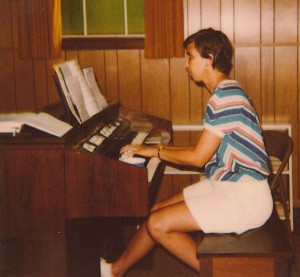
Organist Carolyn Holcombe began playing for the congregation on a “temporary” basis on August 2, 1981, the Sunday after former organist Joan Wageman left with her husband, Pastor Wagerman, who had taken a new call. Still today God continues to bless the congregation with Carolyn’s worship leadership from the keyboard.
The congregation has been blessed through the years with several different organists and instruments for them to play. For example, Sylvia Weick played before Pastor Wageman was installed, when his wife Joan Wageman became the congregation’s organist. Nearly a decade later, on January 1, 1961, a new organ given by Mr. and Mrs. Henry Wieck was dedicated. More than a decade later, in January of 1972, a new Baldwin 711 Model organ was purchased, with the old organ and a piano donated by the Glenn Hudsons traded in to offset the cost. That organ would not fit to the side of the chancel where the previous organs had sat, so it was positioned in the rear of the sanctuary, and what had been partially open space for the organ was enclosed to form the current vestry/sacristy. That Baldwin 711 organ was dedicated on March 25, 1973, and still serves as the organ today. Pilgrim’s current organist, Carolyn Holcombe, was hired on a “temporary” basis more than eight years later, on August, 2, 1981.
In Pilgrim’s office, Pastor Wageman reportedly took care of everything himself, including special bulletins, on a manual typewriter and mimeograph machine. Cindy Harantcavage (nee Wageman) worked with Pastor Piepkorn, and Gayle Gardner was office secretary in 1983. Later, she was joined by Jeanette Paetznick, who served as editor of Pilgrim’s newsletter until she handed off the responsibility in 2012. In September of 2008, Arlene Kuehn was typing and putting out Sunday communion bulletins, and she was given a special thank-you in January 2009. Electronic delivery of newsletters to email addresses began in July 2010, and the congregation’s website was more-fully developed beginning in 2012. Office volunteers in 2012 were Sharon Sampson and Cindy Harantcavage, and Sharon Sampson continued beyond 2012 as the primary office assistant with occasional help from Barbara Wuthrich.
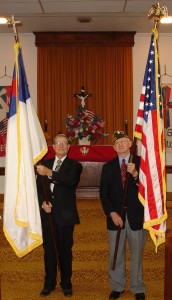
Pilgrim Members Leland Dean (left, a Marine) and Bob Abraham (right, a Navy veteran) pose with flags on July 10, 2005, at the congregation’s Service of Thanksgiving for God and Country. Both men served under combat conditions during World War II.
There have been plenty of opportunities over the years for the office help to prepare special bulletins. On September 16, 1962, the congregation observed a Tenth Anniversary and Mission Festival. On that occasion, Pastor Wageman noted, “As we rejoice over these blessings showered upon us as individuals, we should also be thankful for God’s blessings received from our fellow Lutherans of the Texas District. Through the Mission Board we received a monthly subsidy so we might properly carry on our work. From the Church Extension Fund we have received generous loans for the purchase of the church site, for construction of the church building, and for a down payment on the parsonage. Without the assistance God has given us through these agencies our existence as a congregation would be nigh unto impossible.” On September 17, 1972, there was a Mission Service celebrating the 20th anniversary. On January 16, 1994, the congregation held a Special Service of Thanksgiving with Executive Director of the Mission Board Rev. Ken Hennings delivering the message. On Reformation Day, October 27, 2002, Pilgrim celebrated its 50th Anniversary, with the Rev. Harold Wageman delivering the sermon. In July of 2004 and 2005, there was a Service of Thanksgiving for God and Country, and Services of Renewal were held annually between 2003 and 2008, using talent surveys with the intent of encouraging people to participate more in the life of the congregation. And, the 60th Anniversary Vespers with Sanctuary Rededication were scheduled for September 30, 2012.

Former pastor Rev. Harold Wageman and then-current interim pastor Rev. Joseph C. Lowery pose for a picture together after Pilgrim’s 50th anniversary service on its observance of Reformation Day, October 27, 2002. Rev. Wageman was the guest preacher on that occasion.
Pilgrim’s personnel have had an impact beyond her immediate area. For example, during his tenure, Rev. Wageman served vacancies in Tyler (1962-1963), Palestine (1964-1965, 1973-1975), Nacogdoches (1967), and Longview (1976). He edited the Texas Messenger supplement to The Lutheran Witness (1969-1983), and he broadcast more than one year of a 5-minute devotion on the radio (1972-1973). He was Circuit Counselor multiple times and helped plant the first of Pilgrim’s two daughter congregations. In the Summer of 1965, the Mission Board approved working the Longview field out of Kilgore. Services in Longview began the following year, on March 28, 1966, and that group’s acquiring property and organizing the congregation followed quickly; dedication was held in October 29, 1967, including one of Pilgrim’s original charter members. Our Redeemer, Longview, and Pilgrim formed a joint parish until June 21, 1970, when Rev. Joseph Lowery was installed at Longview; Our Redeemer continues to be served by its own pastor today. The second daughter congregation, Prince of Peace Lutheran Church, Henderson, was established in 1984 (Pilgrim had established a preaching station there in 1982) but later folded. Also, Pilgrim’s CPAs served St. John, Athens, and St. Peter, Gun Barrel City, and conducted informational classes about the CPA program for pastors and wives at Concordia College in Austin.
REFLECTIONS WITH A VIEW TO THE FUTURE ↑ Back to top
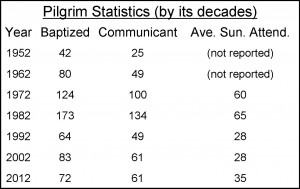 God declares that His Word does not go out and return to Him empty but accomplishes the purpose for which He sends it and succeeds in the thing for which He sends it (Isaiah 55:10-11). Not all of the growth from and fruit of God’s Word is visible to human eyes, but observable numbers can be one indication (for example, Acts 2:41). The first entries in Pilgrim’s official record of membership, in November of 1952, were 24 members by transfer and 1 by confirmation. From there, growth seemed slow but steady. Pilgrim’s first pastor, Rev. J. F. Meyer, made the following remark in his brief notes on the history of the congregation: “The oil field in which this church is located causes much transiency. However, each year, in spite of many transfers, the church continues to slowly grow toward becoming self-sustaining.” Since Pastor Meyer’s remarks, numbers have gone up and down. For example, the apparently record-high regular Sunday morning worship attendance record of 84 was set on March 11, 1962. The adjacent chart gives the official numbers reported to the LCMS for each of Pilgrim’s decades. Behind those numbers are 60 year totals of 190 baptisms (163 infants/children and 27 adults), 173 confirmations, 63 marriages, and 46 funerals.
God declares that His Word does not go out and return to Him empty but accomplishes the purpose for which He sends it and succeeds in the thing for which He sends it (Isaiah 55:10-11). Not all of the growth from and fruit of God’s Word is visible to human eyes, but observable numbers can be one indication (for example, Acts 2:41). The first entries in Pilgrim’s official record of membership, in November of 1952, were 24 members by transfer and 1 by confirmation. From there, growth seemed slow but steady. Pilgrim’s first pastor, Rev. J. F. Meyer, made the following remark in his brief notes on the history of the congregation: “The oil field in which this church is located causes much transiency. However, each year, in spite of many transfers, the church continues to slowly grow toward becoming self-sustaining.” Since Pastor Meyer’s remarks, numbers have gone up and down. For example, the apparently record-high regular Sunday morning worship attendance record of 84 was set on March 11, 1962. The adjacent chart gives the official numbers reported to the LCMS for each of Pilgrim’s decades. Behind those numbers are 60 year totals of 190 baptisms (163 infants/children and 27 adults), 173 confirmations, 63 marriages, and 46 funerals.
In all, some 520 people have come to Pilgrim as members and either stayed or left in one fashion or another. They have been blessed with the Gospel preached in its purity and the holy sacraments administered according to the Gospel, which are the most important things. Along those lines, on the occasion of Pilgrim’s 25th anniversary, Glenn and Ruby Hudson wrote the following in a letter to the congregation: “Sinners though we be, here we have received the beautiful message of forgiveness and told that we are heirs of heaven and SAINTS too! Here we have shared our joys and have been comforted in our sorrows. Here is where our only child began his Christian education in the Nursery Class which was held in the nursery, and where he continued to receive the message of salvation through confirmation into manhood. PILGRIM LUTHERAN CHURCH, small as you may be in structure compared to many church buildings, our family know the majesty for which you so proudly stand on the corner of Broadway and Florey.” Similarly, the only son of the congregation to become a pastor, Volker S. Heide, made the following comment in a letter to the congregation on the occasion of its 60th anniversary: “It would be hard to begin to describe how the pastors and people of Pilgrim Lutheran Church helped to shape my spiritual life. What I learned of Christ at Pilgrim eventually led me on the path to becoming a pastor. I give thanks for all the faithful pastors and the many families of Pilgrim Lutheran that I knew during my time there. I have to especially thank Pastor Harold Wageman for the example he set as a faithful shepherd of God’s flock. Again, what I know of Christ as my Savior today, I learned at that small church at 713 Florey in Kilgore, Texas. And I praise God that there was a faithful Lutheran Church there for me and my family.”
Keeping the congregation going through the 60 years, especially those years without a pastor, was not easy, humanly speaking. Rev. Gregg Stanton, who served Pilgrim between the times she was served by Our Redeemer’s CPAs and by Pilgrim’s own CPAs, made the following comment in his letter to the congregation on the occasion of its 60th anniversary. “What I remember most is your faith and trust in the Lord of the church as He has led you these many years. It is a tenacious faith that holds on to the Gospel, and a thirst for the means of grace – the Word, Baptism, and the Lord’s Supper. How easy it would have been to cave in and give up over the years, but you would not, because your faith is in the One who would not give up on us, seen most clearly on the cross, in His victory over sin and death.”
What does God have in store for Pilgrim Lutheran Church in the future? In one sense, only God knows. But, in another sense we know He wants us to continue faithfully preaching the pure Gospel and rightly administering the Sacraments, and we know He will continue to create faith when and where He pleases in those who hear that Gospel, which teaches that we have a gracious God, not by our own merits but by the merit of Christ. God alone grows His Church in that way. Will there always be Pilgrim Lutheran Church in Kilgore? Again, only God knows. We certainly pray that there will be, but we also know that if God in His wisdom would permit this congregation to cease to exist as such, then He would continue to provide for His people here in some other way. He rules all for the benefit of His Church as a whole, and that Church prevails against the gates of hell! In the Church’s triumph through the forgiveness of sins by grace through faith in Christ Jesus our Lord, we have reason to praise God far greater than the “60 years of salvation in this house”, as great of a reason as that is!
To make corrections to Our History or to add information or anecdotes, please email the church secretary at secretary@pilgrimlc.org.

